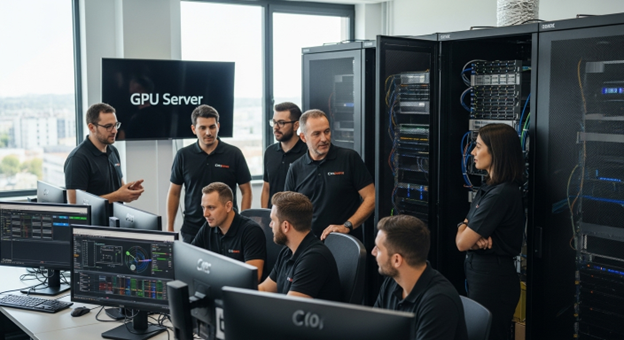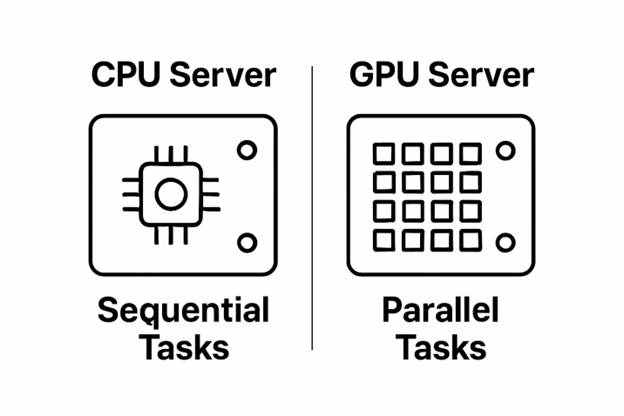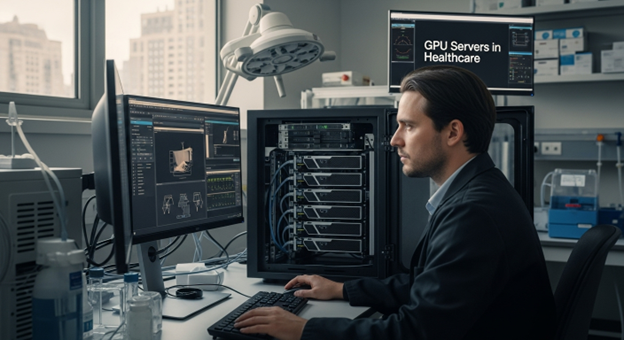
GPU servers are changing how we solve complex problems in tech, science, and business. Most people are shocked when they find out that GPU servers can process tasks up to 100 times faster than standard servers, according to NVIDIA research. But these systems are not just about speed or flashy hardware—they are quietly empowering entire industries to tackle projects that once seemed impossible to complete.
| Takeaway | Explanation |
|---|---|
| GPU servers revolutionize computing capabilities | They utilize graphics processing units for high-performance computational tasks, surpassing traditional CPU-based systems. |
| Parallel processing significantly accelerates workloads | GPU servers can execute thousands of tasks simultaneously, improving processing speed by ten to one hundred times. |
| Essential for machine learning and AI | These servers enhance deep learning model training and support complex simulations, transforming data analysis in various fields. |
| Foundational in multiple industries | GPU servers are key in healthcare, financial services, and scientific research, driving advancements and efficiencies across sectors. |
| Future trends focus on intelligent systems | Emerging GPU technologies aim for higher efficiency and adaptability, integrating advanced AI for optimized performance management. |
A GPU server represents a powerful computing system specifically designed to leverage graphics processing units (GPUs) for high-performance computational tasks beyond traditional graphics rendering. Unlike standard servers that rely primarily on central processing units (CPUs), GPU servers harness the parallel processing capabilities of specialized graphics cards to accelerate complex computational workloads.
GPU servers are engineered with multiple high-performance graphics cards integrated into a single system, creating a robust computational infrastructure. These servers typically feature advanced cooling mechanisms, high-bandwidth interconnects, and substantial memory configurations to support intensive computational demands. The primary objective is to distribute complex computational tasks across numerous GPU cores simultaneously, enabling significantly faster processing compared to traditional CPU-based systems.
Explore our advanced GPU server solutions that can transform your computational capabilities.
The computational versatility of GPU servers makes them indispensable across various domains:
What distinguishes GPU servers is their ability to execute thousands of computational threads concurrently, delivering exponential performance improvements over traditional computing architectures. By distributing workloads across multiple GPU cores, these servers can process massive datasets and perform intricate mathematical computations at unprecedented speeds.
Understanding GPU servers requires recognizing them not just as hardware solutions, but as transformative computational platforms that redefine processing capabilities across industries.
The table below provides an at-a-glance comparison of GPU servers and traditional CPU servers, helping clarify their key differences in architecture, processing abilities, and impact on computational workloads.
| Feature | GPU Servers | Traditional CPU Servers |
|---|---|---|
| Core Processing Unit | Graphics Processing Units (GPUs) | Central Processing Units (CPUs) |
| Architecture | Parallel processing with thousands of cores | Sequential processing with fewer cores |
| Speed Improvement | 10x–100x faster for specific workloads | Baseline speed for general tasks |
| Tasks Optimized For | Complex computations, AI, data analytics, simulations | General-purpose computing |
| Common Applications | AI training, scientific research, financial modeling | Web hosting, standard business software |
| Memory Bandwidth | High; supports rapid data transfers | Moderate; limits parallel task handling |
| Energy Efficiency | High for parallel tasks | Lower for data-parallel applications |
| Their parallel processing architecture represents a fundamental shift in how we approach complex computational challenges. |

GPU servers have emerged as critical infrastructure in contemporary technological ecosystems, revolutionizing computational capabilities across multiple complex domains. These powerful systems represent far more than simple hardware upgrades they fundamentally transform how organizations process, analyze, and extract value from massive datasets.
The significance of GPU servers lies in their unprecedented ability to accelerate computational workloads. While traditional CPU servers process tasks sequentially, GPU servers can execute thousands of parallel computations simultaneously. Learn more about high-performance computing infrastructure and understand how these systems are reshaping technological capabilities.
According to NVIDIA research, GPU servers can deliver performance improvements ranging from 10x to 100x faster than conventional computing architectures. This exponential speed enhancement enables breakthrough innovations in multiple sectors.
The strategic importance of GPU servers extends beyond raw computational power. They represent a paradigm shift in how complex problem solving occurs across critical industries:
Moreover, GPU servers are not merely technological tools they are transformative platforms that democratize access to high-performance computing. By providing unprecedented computational density and efficiency, these systems allow smaller organizations to tackle challenges previously reserved for large research institutions or technology giants.
The economic implications are profound. Organizations leveraging GPU server technologies can dramatically reduce computational time, lower energy consumption, and generate insights with unprecedented speed and accuracy. This technological edge translates directly into competitive advantage across research, industry, and innovation ecosystems.

GPU servers represent sophisticated computational systems engineered to maximize parallel processing capabilities through intricate hardware and software configurations. Their operational architecture goes far beyond traditional server designs, creating specialized environments optimized for handling complex computational workloads.
At the core of GPU server functionality are multiple graphics processing units integrated into a unified computational framework. These systems leverage high-bandwidth interconnects and specialized memory architectures to enable rapid data transfer and simultaneous processing across thousands of computational cores. Explore cutting-edge AI computing infrastructure trends to understand the evolving landscape of computational technologies.
According to computational research from ACM Digital Library, GPU servers utilize advanced memory management techniques that allow seamless data movement between central processing units, graphics processing units, and storage subsystems, creating unprecedented computational efficiency.
The fundamental operational principle of GPU servers revolves around parallel computational processing. Unlike traditional CPU servers that process tasks sequentially, GPU servers distribute complex computational tasks across numerous specialized cores simultaneously. This architecture enables exponential performance improvements across various computational domains.
Key operational characteristics include:
The intricate design of GPU servers allows them to excel in workloads requiring simultaneous mathematical computations, such as machine learning model training, scientific simulations, and complex data analytics. By breaking down massive computational problems into smaller, manageable threads processed in parallel, these servers dramatically reduce processing time and enhance overall computational efficiency.
Understanding GPU server functionality requires recognizing them as dynamic, adaptable computational platforms that fundamentally transform how complex computational challenges are approached across multiple technological domains.
GPU servers have transcended their original graphical rendering purpose, emerging as transformative computational platforms that drive innovation across diverse industrial sectors. Their unprecedented parallel processing capabilities enable breakthrough technological solutions that were previously unimaginable.
In scientific research, GPU servers are revolutionizing complex computational domains. Researchers leverage these powerful systems for intricate simulations ranging from climate modeling to quantum mechanics. Discover advanced computing infrastructure strategies to understand how computational technologies are reshaping research methodologies.
According to research from IEEE, GPU servers play a critical role in autonomous vehicle development, supporting real-time sensor data processing and complex AI algorithmic decision-making frameworks. This demonstrates their versatility beyond traditional computational boundaries.
The impact of GPU servers extends across multiple industrial landscapes, driving technological innovation through advanced computational capabilities:
GPU servers represent more than computational tools they are catalysts for technological transformation. By providing unprecedented processing power, these systems enable organizations to tackle increasingly complex challenges across research, industry, and innovation ecosystems.
The computational density and efficiency of GPU servers allow smaller organizations to compete with technological giants, democratizing access to high-performance computing resources.
The following table details the major industries and application areas where GPU servers deliver transformative impact, summarizing their technical contributions and business value in each sector.
| Industry / Sector | Main Use Case | Impact / Benefit |
|---|---|---|
| Healthcare | Medical imaging, genomic research | Faster diagnostics and research insights |
| Financial Services | Risk modeling, algorithmic trading | Rapid analysis and improved decision speed |
| Scientific Research | Simulations, big data analysis | Enables breakthrough discoveries |
| Artificial Intelligence | Deep learning model training, AI inference | Accelerated training and processing |
| Entertainment | Graphics rendering, immersive experiences | Real-time rendering and enhanced visuals |
| Autonomous Vehicles | Real-time sensor data processing, algorithm testing | Improved speed and safety in operations |
| Cryptocurrency Mining | Blockchain transaction processing | Maximized computational efficiency |
| This technological democratization is reshaping competitive landscapes across global industries, enabling more organizations to leverage advanced computational capabilities for breakthrough innovations. |
The landscape of GPU server technology is undergoing rapid transformation, driven by exponential advancements in artificial intelligence, machine learning, and high-performance computing. These technological shifts are reshaping computational infrastructure, creating more powerful, efficient, and adaptable systems that promise to revolutionize computational capabilities across multiple domains.
Future GPU server architectures are moving towards increasingly specialized and integrated designs. Manufacturers are developing systems with tighter CPU-GPU integration, enhanced memory architectures, and more efficient interconnect technologies. Explore cutting-edge AI computing infrastructure developments to understand the emerging technological landscape.
According to research from Nature, emerging GPU technologies are focusing on three critical evolutionary directions:
The next generation of GPU servers will likely emphasize intelligent computational ecosystems that can dynamically adapt to varying workload requirements. These systems will incorporate advanced machine learning algorithms capable of self-optimization, predictive maintenance, and real-time performance tuning.
Key technological trends include the development of more energy-efficient architectures, quantum computing interfaces, and neuromorphic computing capabilities. These advancements suggest a future where GPU servers are not merely computational tools but intelligent, adaptive platforms that can learn, predict, and optimize their own performance.
The convergence of artificial intelligence, edge computing, and GPU server technologies promises to unlock unprecedented computational potential, enabling more complex, nuanced, and sophisticated computational solutions across scientific research, industrial applications, and technological innovation.
Struggling with slow research cycles or AI projects that hit a wall because your current infrastructure just can’t keep up? As explored in our article, the power of GPU servers goes beyond basic computation. The real challenge is securing scalable, high-performance hardware that matches your demanding workloads and lets your team focus on innovation—not outdated equipment or complicated procurement. With Nodestream’s high-performance computing marketplace, you get verified listings, real-time inventory, and tailored solutions for all your AI, machine learning, or enterprise computing needs.
Ready to make slowdowns and outdated infrastructure a thing of the past? Visit https://nodestream.blockwaresolutions.com to explore bulk ordering, customized support, and enterprise service built for organizations that refuse to compromise on speed or transparency. Secure the right GPU servers now and move your projects forward with confidence.
A GPU server is a powerful computing system designed to utilize graphics processing units (GPUs) for high-performance computational tasks, enabling faster processing for complex workloads compared to traditional CPU-based systems.
GPU servers leverage parallel processing capabilities, allowing them to execute thousands of computations simultaneously. This results in significant performance improvements, enabling faster data processing across various applications such as AI and scientific research.
GPU servers are essential in diverse fields, including machine learning and AI training, scientific research, financial modeling, and cryptocurrency mining. They handle complex computations and large datasets efficiently, making them invaluable for innovation.
The future of GPU server technology includes advancements in architectural innovations focusing on increased computational density, energy efficiency, and integration of artificial intelligence. These developments aim to create intelligent and adaptive computing platforms for various applications.